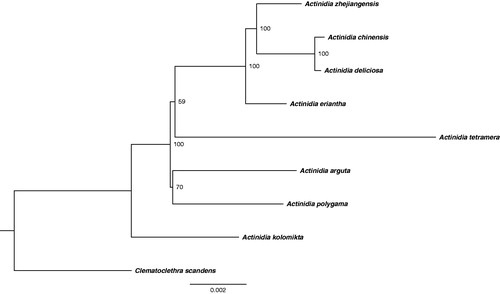Abstract
The complete chloroplast (cp) genome sequence of Actinidia zhejiangensis was assembled and characterized by Illumina paired-end data in this study. The complete chloroplast genome of Actinidia zhejiangensis is 156,717 bp in length, containing a large single copy region (LSC) of 86,483 bp and a small single copy region (SSC) of 22,574 bp, which was separated by a pair of 23,840 bp inverted repeat regions (IR). A total of 128 genes are detected, including 81 protein-coding genes, 39 tRNA genes, 8 ribosomal RNA genes. The phylogenetic position based on the chloroplast genome showed that Actinidia zhejiangensis was sister to the group A. deliciosa and A. chinensis.
Actinidia zhejiangensis, a local species variety named after its origin, in mountain areas across Zhejiang province in East China, has earned popularity for a unique flavor, pleasing taste, and rich nutrients, e.g. Vitamin C, soluble solids, invert sugar, acid. The species, however, is faced with degradation and loss of habitats. According to The International Union for Conservation of Nature (IUCN), the status of Actinidia zhejiangensis is Critically Endangered (CR). In this study, we reported the complete chloroplast genome of Actinidia zhejiangensis based on the next generation sequencing data and uncovered its phylogenetic relationship with seven Actinidiaceae species of which complete chloroplast genomes are available.
The voucher specimen of Actinidia zhejiangensis was stored at Chinese Virtual Herbarium (CVH). We isolated the total genomic DNA from fresh leaves using a modified CTAB method (Doyle and Doyle Citation1987) and sequenced it based on the Illumina pair-end technology. Then, we used the program NOVO-Plasty to assemble the filtered reads (Dierckxsens et al. Citation2017) and used the sequenced cp genome of its close relative A. eriantha (GenBank accession no. NC_034914.1) as the reference. Annotations of chloroplast genome were conducted by the program Plann (Huang and Cronk Citation2015) and annotations were corrected using Geneious (Kearse et al. Citation2012). We determined the Actinidia zhejiangensis whole chloroplast genome sequence and deposited it to GenBank under the accession number of MK318825.
The complete plastid genome of Actinidia zhejiangensis is 156,717 bp in length. The genome, displaying a typical quadripartite structure found in most chloroplast genomes of plants, possesses a large single-copy region (LSC) of 86,483 bp, a small single-copy region (SSC) of 22,574 bp, and a pair of inverted repeat regions (IR) (IRa and IRb, 23,840 bp). In addition, the genome possesses 128 genes in total, including 81 protein-coding genes, 39 distinct tRNA genes, and 8 rRNA genes. Most of these genes are in a single copy, however, 4 rRNA genes (i.e. 4.5S, 5S, 16S, and 23S rRNA), 7 protein-coding genes (i.e. ndhB, rpl23, rps12, rps19, rps7, ycf15, and ycf2), and 8 tRNA genes (i.e. trnH-GUG, trnI-CAU, trnL-CAA, trnI-GAU, trnV-GAC, trnA-UGC, trnR-ACG, trnN-GUU) occur in double copies. The overall GC-content of the whole plastome is 37.2%.
Furthermore, the phylogenetic position of Actinidia zhejiangensis was determined using a maximum likelihood (ML) tree which was constructed based on whole chloroplast genome sequences of eight Actinidiaceae plants using RAxML (Stamatakis Citation2014) with 1000 bootstrap replicates. All the sequences were first aligned by MAFFT (Katoh and Standley Citation2013). Our results showed that Actinidia zhejiangensis is sister to the group A. deliciosa, and A. chinensis ().
Figure 1. Phylogenetic relationships of 9 seed plants based on plastome sequences. Bootstrap percentages are indicated for each branch. GenBank accession numbers: Actinidia arguta (NC_034913.1), Actinidia chinensis (NC_026690.1), Actinidia deliciosa (NC_026691.1), Actinidia eriantha (NC_034914.1), Actinidia kolomikta (NC_034915.1), Actinidia polygama (NC_031186.1), Actinidia tetramera (NC_031187.1), Actinidia zhejiangensis (Unpublished), and Clematoclethra scandens subsp. hemsleyi (KX345299.1).

Disclosure statement
The authors report no conflicts of interest. The authors alone are responsible for the content and writing of this article.
Additional information
Funding
References
- Dierckxsens N, Mardulyn P, Smits G. 2017. NOVOPlasty: de novo assembly of organelle genomes from whole genome data. Nucleic Acids Res. 45:e18.
- Doyle JJ, Doyle JL. 1987. A rapid DNA isolation procedure for small quantities of fresh leaf tissue. Phytochem Bull. 19:11–15.
- Huang DI, Cronk QCB. 2015. Plann: a command-line application for annotating plastome sequences. Appl Plant Sci. 3:1500026.
- Katoh K, Standley DM. 2013. MAFFT multiple sequence alignment software version 7: improvements in performance and usability. Mol Biol Evol. 30:772–780.
- Kearse M, Moir R, Wilson A, Stones-Havas S, Cheung M, Sturrock S, Buxton S, Cooper A, Markowitz S, Duran C, et al. 2012. Geneious Basic: an integrated and extendable desktop software platform for the organization and analysis of sequence data. Bioinformatics. 28:1647–1649.
- Stamatakis A. 2014. RAxML version 8: a tool for phylogenetic analysis and post-analysis of large phylogenies. Bioinformatics. 30:1312–1313.
